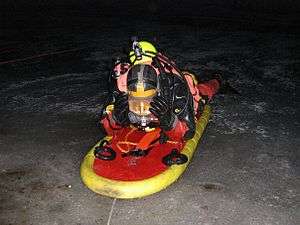Public safety diving

Public safety diving is the underwater work conducted by law enforcement, fire rescue, and search & rescue/recovery dive teams. Public safety divers differ from recreational, scientific and commercial divers who can generally plan the date, time, and location of a dive, and dive only if the conditions are conducive to the task. Public safety divers respond to emergencies 24 hours a day, 7 days a week, and may be required to dive in the middle of the night, during inclement weather, in zero visibility "black water," or in waters polluted by chemicals and biohazards.[1]
Specialized skills
In addition to basic diving skills training, public safety divers require specialized training for recognizing hazards, conducting risk assessments, search procedures, diving in zero visibility, using full-face masks with communication systems, and recovering evidence that is admissible in court. Some of the water they are required to dive in is contaminated, and they may be required to wear vulcanized drysuits, with diving helmets sealed to the suit, and utilize surface supplied air. At times, the decontamination process that takes place out of the water can be longer than the dive time.[1]
Public safety diving personnel
In the USA, many public safety divers are volunteers, but career law enforcement or fire rescue personnel also often take on these additional responsibilities as part of their occupation. Firefighters will find the diving equipment has similarities to the full face masks and breathing apparatus worn in smoke filled environments.
Law enforcement personnel are also trained as public safety divers because of their training and experience in handling evidence and presenting evidence in court.[1]
Health and Safety aspects
Jurisdiction
USA
Depending on state legislation, public safety divers in the USA may fall under state or federal occupational safety and health legislation. Federal legislation applies where there is no relevant state legislation and the divers are employees diving as part of their occupation. If they fall under federal legislation they are exempt (excluded) from specific requirements of 29 CFR Part 1910, Subpart T, Commercial Diving Operations, only during diving activities incidental to police and public-safety functions the purpose of which is to provide search, rescue, or public-safety diving services. The exemption was written to include the ability to deviate from safe diving practices under limited conditions where compliance would be impracticable due to time constraints or the possible consequences of failing to perform the task overwhelm the risks taken using available facilities. This exclusion does not apply during training, recovery operations, searches where there is no reasonable probability of rescue of a living person or there is no real and immediate public safety hazard. The specific federal legislation does not apply to volunteers where there is no employer/employee relationship.[2]
See also
References
- 1 2 3 Blades Robinson, (11/01/02). What is public safety diving, http://www.sandiegodiving.com/education/items/9.html , accessed 2 June 2012
- ↑ Phillips, Mark (November 2015). "Public Safety Diving and OSHA, Are We Exempt? Final Answer." (PDF). PS Diver Magazine. Mark Phillips. Retrieved 7 June 2016.
Further reading
- Howard, Eric. Monson, John. (2002) Downtime: An Oral History Of The Lee's Summit Underwater Rescue & Recovery Team. Bookstand Publishing ISBN 1-58909-095-0
External links
More information on public safety divers, their training, and their equipment.
- International Association of Dive Rescue Specialists
- Dive Rescue International
- Trelleborg - Viking
- Kirby Morgan Dive Systems
- http://publicsafetydivetraining.com/ Naui Worldwide Public Safety Diver Certification
- https://www.osha.gov/OshDoc/Directive_pdf/CPL_02-00-151.pdf US Department of Labor OSHA Instruction: Directive number: CPL 02-00-151

















